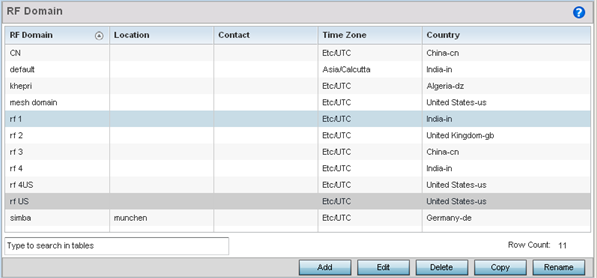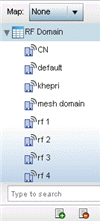Managing RF Domains
Managing RF Domains entails setting individual RF Domain configurations and administrating them as a collective set. Remember that access points, unlike controllers and service platforms, use only a single RF Domain shared among peer access points of the same model.
To review the configurations of existing RF Domains:
- Select from the Web UI. Access points select RF Domains
using a path of .
The RF Domain screen displays within the main portion of the Web UI, and the RF Domain Browser displays in the lower, left-hand, portion of the Web UI.
- Refer to the RF
Domain screen to review high-level configuration
data for existing RF Domain policies.RF Domains Screen

- Use the following (read-only)
information to determine whether a new RF Domain policy requires creation, or an
existing RF Domain requires edit or deletion:
RF Domain Lists each policy's name, as assigned when it was created. The RF Domain name cannot be changed as part of the edit process. Only one RF Domain can be assigned to a controller or access point at one time. Location Displays the physical location assigned to the RF Domain. This name could be as specific as the floor of a building, or as generic as an entire site. The location defines the physical area where a common set of devices are deployed using the policy's RF Domain configuration. Contact Lists the contact (administrator) assigned to respond to events created by, or impacting, each listed RF Domain. Time Zone Displays the geographic time zone set for each RF Domain policy. RF Domains can contain unique country codes and time zone information for controllers and access points deployed across different states or countries, thus making them ideal for managing device configurations across different geographical deployments. Country Code Display the two-digit country code set for the policy. The country code must be set accurately to avoid illegal operation, as device radios transmit in specific channels unique to their country of operation. - Refer to the RF Domain Browser to
expand an existing policy and review the members of that controller, service platform
or access point RF Domain.RF Domain Browser

- Once the data within the RF Domain screen and RF Domain Browser is reviewed, determine whether a new policy requires creation, or if an existing policy requires edit or deletion. The management of RF Domains entails the following:



